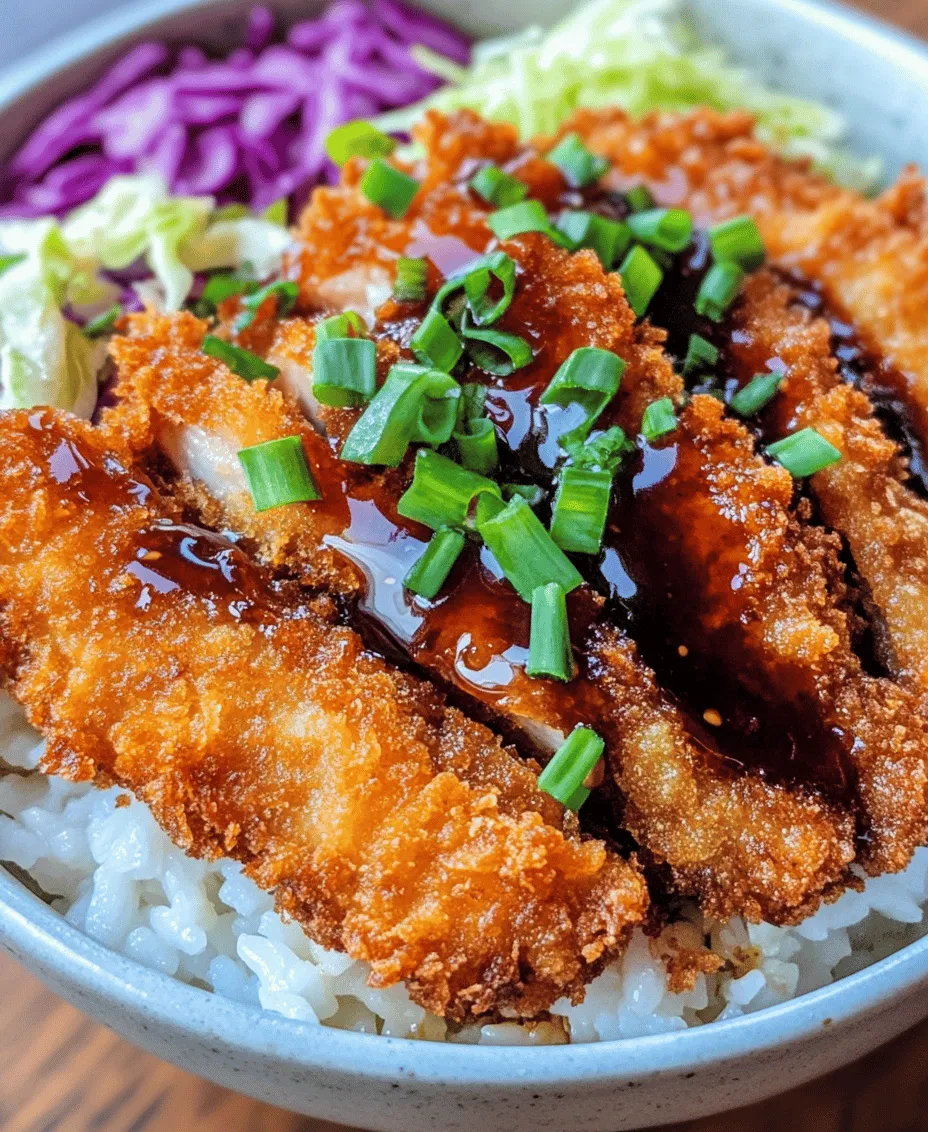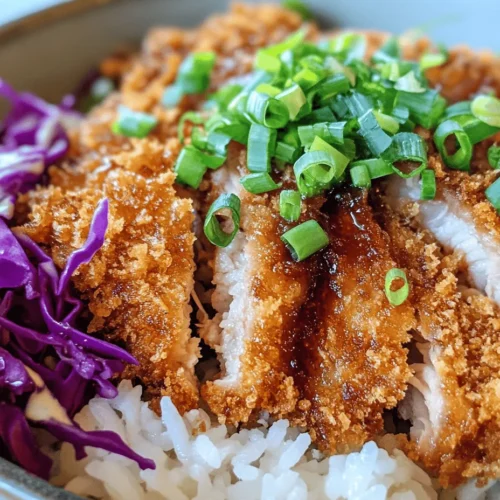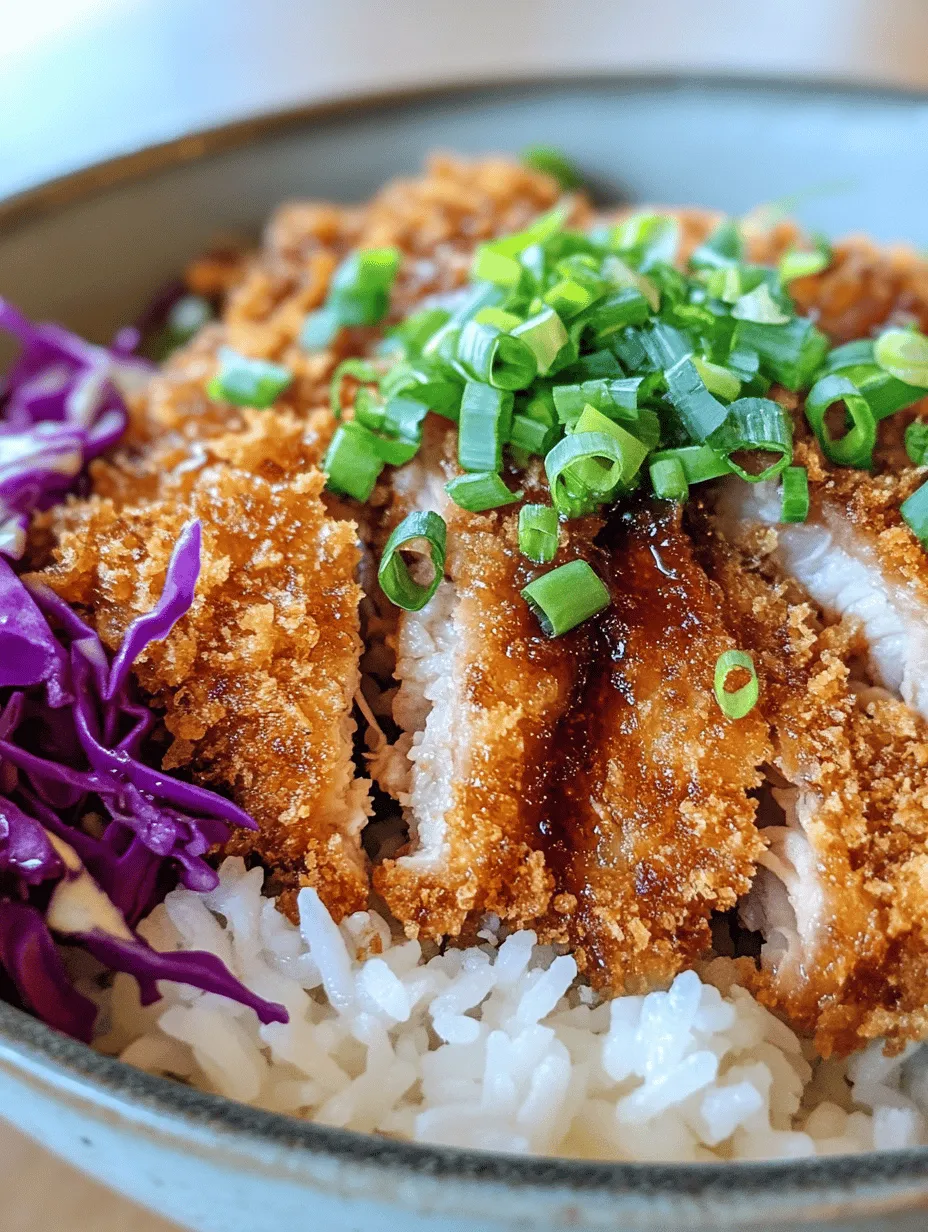Introduction
In the world of Japanese cuisine, katsu dishes have gained immense popularity, celebrated for their crunchy texture and savory flavors. From bustling izakayas to home kitchens, katsu, which translates to “cutlet,” has become a beloved staple. The dish typically features breaded and fried meat, served with a tangy sauce, making it a favorite among both locals and visitors. Today, we are excited to share a detailed recipe for Crispy Katsu Bowls with Homemade Tonkatsu Sauce, a dish that perfectly captures the essence of katsu while offering versatility with your choice of protein. Whether you opt for tender pork chops or juicy chicken breasts, this recipe promises a delightful crunch and a burst of flavor that will leave you wanting more.
The appeal of katsu bowls lies not only in their taste but also in their presentation. Served over a bed of fluffy rice and adorned with fresh garnishes, these bowls are as visually appealing as they are delicious. The contrast between the crispy katsu and the light, refreshing toppings creates a well-balanced meal that is perfect for lunch or dinner. With homemade tonkatsu sauce that adds a layer of complexity and richness, this dish is sure to impress family and friends alike.
Understanding Katsu: A Cultural Culinary Icon
To truly appreciate the Crispy Katsu Bowls, it’s essential to understand the cultural significance of katsu in Japanese cuisine. Katsu is believed to have been introduced to Japan in the late 19th century, influenced by Western culinary practices during the Meiji Restoration. Originally a Western-style dish, katsu has evolved into a quintessential part of Japanese fare, with its own unique twists and variations.
There are several popular forms of katsu, including chicken katsu, pork katsu, and even vegetarian options like eggplant katsu. Each variation offers its own flavor profile and texture, appealing to a diverse array of palates. Chicken katsu is often favored for its mild flavor and tenderness, while pork katsu, made from juicy cuts of pork, is celebrated for its richness. Vegetarian katsu options provide an excellent alternative for those seeking plant-based meals, showcasing the adaptability of this beloved dish.
In Japan, katsu holds more than just culinary significance—it is often seen as a comfort food that brings people together. Katsu is a common feature at casual dining establishments, school lunches, and family dinners, symbolizing warmth and hospitality. The dish is also celebrated during special occasions, such as shōgatsu (New Year), where it is served as a symbol of good fortune and success. By preparing katsu at home, you’re not just making a meal; you’re partaking in a cultural tradition that has spanned generations.
Essential Ingredients for Crispy Katsu Bowls
To create the perfect Crispy Katsu Bowls, you’ll need to gather a selection of essential ingredients. Each component plays a significant role in achieving the dish’s signature flavors and textures.
Boneless Pork Chops or Chicken Breasts
The star of this recipe is undoubtedly the protein, which can be either boneless pork chops or chicken breasts. Choosing high-quality cuts is crucial; opt for pork chops with a bit of fat for added flavor and tenderness, while chicken breasts should be plump and fresh. The meat should be pounded to an even thickness to ensure even cooking, resulting in a juicy and tender katsu.
Panko Breadcrumbs
Panko breadcrumbs are the secret ingredient that gives katsu its signature crunch. Unlike traditional breadcrumbs, panko is made from crustless white bread that is coarsely ground, resulting in a lighter and airier texture. This allows for greater crispiness when fried, creating a delightful contrast with the tender meat inside. If you’re looking for an authentic katsu experience, panko is a must-have in your pantry.
Japanese Rice
Rice is the foundation of many Japanese meals, and katsu is no exception. For this dish, short-grain Japanese rice is the ideal choice due to its sticky texture when cooked. This characteristic allows the rice to hold together well, making it easy to scoop up with chopsticks. Preparing the rice properly is essential; rinsing the grains thoroughly before cooking removes excess starch, resulting in fluffy, perfectly cooked rice that complements the katsu beautifully.
Shredded Cabbage and Green Onions
To elevate your katsu bowls, garnishes like shredded cabbage and chopped green onions add a refreshing crunch and vibrant color. The crispiness of the cabbage provides a nice contrast to the rich flavors of the katsu, while the green onions offer a subtle hint of sharpness. These garnishes not only enhance the dish visually but also contribute to a well-rounded flavor profile, balancing the richness of the fried meat.
Homemade Tonkatsu Sauce: The Flavorful Foundation
No katsu bowl is complete without a drizzle of homemade tonkatsu sauce, a savory condiment that elevates the dish to new heights. Tonkatsu sauce is a thick, tangy sauce that combines sweet and savory flavors, making it the perfect accompaniment to the crispy cutlet. The sauce is typically made from a blend of ingredients that balance sweetness, acidity, and umami.
Traditional Ingredients for Tonkatsu Sauce
The traditional ingredients for making tonkatsu sauce include ketchup, Worcestershire sauce, soy sauce, mirin, sugar, Dijon mustard, garlic powder, and ground ginger. Each component plays a vital role in creating the sauce’s signature depth of flavor:
– Ketchup: Provides sweetness and a rich tomato flavor that serves as the base of the sauce.
– Worcestershire Sauce: Adds a complex mix of tangy and savory notes, enhancing the overall flavor.
– Soy Sauce: Offers umami and saltiness, balancing the sweetness of the ketchup.
– Mirin: A sweet rice wine that contributes depth and a slight sweetness to the sauce.
– Sugar: Enhances the overall sweetness, creating a well-rounded flavor.
– Dijon Mustard: Adds a hint of spice and acidity that cuts through the richness of the katsu.
– Garlic Powder and Ground Ginger: Provide aromatic notes that deepen the sauce’s complexity.
Step-by-Step Breakdown of How to Make Tonkatsu Sauce
Making homemade tonkatsu sauce is simple and requires minimal effort. Here’s how to do it:
1. Combine Ingredients: In a medium bowl, mix together 1/2 cup of ketchup, 2 tablespoons of Worcestershire sauce, 1 tablespoon of soy sauce, 1 tablespoon of mirin, and 1 tablespoon of sugar.
2. Add Flavorings: Stir in 1 teaspoon of Dijon mustard, 1/2 teaspoon of garlic powder, and 1/2 teaspoon of ground ginger.
3. Adjust to Taste: Taste the sauce and adjust any ingredients according to your preference. If you like it sweeter, add more sugar. For a tangier flavor, consider increasing the Worcestershire sauce or soy sauce.
4. Store for Later: If you have leftovers, the sauce can be stored in an airtight container in the refrigerator for up to two weeks.
With this homemade tonkatsu sauce, you’ll infuse your katsu bowls with an authentic flavor that elevates the dish from ordinary to extraordinary.
The Preparation Process: Step-by-Step Guide
Now that you have a solid understanding of the essential ingredients and the flavorful tonkatsu sauce, it’s time to delve into the preparation process. The following steps will guide you through creating your own Crispy Katsu Bowls with Homemade Tonkatsu Sauce.
Preparing the Tonkatsu Sauce
As mentioned, the first step is to whip up your homemade tonkatsu sauce. This can be done in advance to allow the flavors to meld together. Follow the steps outlined above, and set the sauce aside while you prepare the katsu.
In the next section, we will cover the detailed steps for preparing the katsu itself, including breading and frying techniques to ensure you achieve that perfect crispy texture. Stay tuned for a culinary adventure that will transform your kitchen into a Japanese bistro!
 Crispy Katsu Bowls with Homemade Tonkatsu Sauce, a dish that perfectly captures the essence of katsu while offering versatility with your choice of protein. Whether you opt for tender pork chops or juicy chicken breasts, this recipe promises a delightful crunch and a burst of flavor that will leave you wanting more.” />
Crispy Katsu Bowls with Homemade Tonkatsu Sauce, a dish that perfectly captures the essence of katsu while offering versatility with your choice of protein. Whether you opt for tender pork chops or juicy chicken breasts, this recipe promises a delightful crunch and a burst of flavor that will leave you wanting more.” />
Clear Instructions for Mixing Ingredients and Setting Aside
To prepare the crispy katsu bowls with homemade tonkatsu sauce, you’ll want to start by mixing your ingredients for the sauce. In a small mixing bowl, combine ¼ cup of ketchup, 2 tablespoons of Worcestershire sauce, 1 tablespoon of soy sauce, 1 tablespoon of mirin (or rice vinegar), 1 teaspoon of sugar, and a pinch of ground ginger. Whisk these ingredients together until fully combined. Adjust the sweetness or tanginess to your taste by adding a little more sugar or vinegar as desired. Once mixed, set the tonkatsu sauce aside, allowing the flavors to meld while you focus on preparing the meat and the rest of the dish.
Preparing the Meat
For this recipe, boneless chicken thighs or pork cutlets work wonderfully. If using chicken, a thigh cut provides more moisture and flavor than chicken breast. Begin by lightly pounding the meat to an even thickness of about ½ inch. This not only helps in cooking the meat evenly but also enhances tenderness.
Next, season both sides of the meat liberally with salt and freshly ground black pepper. Seasoning is crucial as it enhances the natural flavors of the meat, ensuring that every bite is flavorful. Allow the seasoned meat to rest for about 10-15 minutes at room temperature. This brief resting period helps the meat absorb the flavors and improves the overall taste of your katsu.
The Breading Process
The breading process is essential to achieving that signature crispy texture of katsu. You will need three shallow dishes for the breading: one for all-purpose flour, another for beaten eggs, and the last for panko breadcrumbs.
1. Flour: Start by placing about 1 cup of all-purpose flour in the first dish. The flour will help the egg adhere to the meat.
2. Eggs: In the second dish, beat 2 large eggs until the yolks and whites are fully combined. The eggs will create a moist barrier that holds the breadcrumbs in place.
3. Panko Breadcrumbs: Finally, pour approximately 1-2 cups of panko breadcrumbs into the third dish. Panko, a Japanese-style breadcrumb, is larger and coarser than regular breadcrumbs, contributing to that signature crunch.
To bread the meat, take one piece and first coat it in flour, shaking off any excess. Next, dip it into the beaten egg, ensuring it is fully coated. Finally, dredge it in panko breadcrumbs, pressing gently to ensure an even coat. Repeat this process with each piece of meat. For an extra crunchy texture, consider double-breading by repeating the egg and panko steps for each cutlet.
Frying the Meat
When it comes to frying, oil temperature plays a crucial role in achieving that perfect crisp. In a large frying pan or deep skillet, pour in enough vegetable oil to reach a depth of about ½ inch, and heat it over medium-high heat until it reaches 350°F (175°C). You can test the oil’s readiness by dropping a few breadcrumbs into the oil; if they sizzle and float to the top, the oil is hot enough.
Carefully place the breaded meat into the hot oil, ensuring not to overcrowd the pan, which can lower the oil temperature. Fry each piece for about 3-4 minutes on each side or until they are golden brown and cooked through. The internal temperature of the meat should reach at least 165°F (74°C) for chicken or 145°F (63°C) for pork. Remember to use a meat thermometer for accuracy.
Once cooked, transfer the katsu to a plate lined with paper towels to absorb any excess oil. Allow them to rest for a few minutes before slicing. This resting period helps the juices redistribute, ensuring the meat remains juicy.
Assembling the Bowls
Now that the katsu is perfectly fried, it’s time to assemble your bowls. Start with a base of perfectly cooked rice—short-grain sushi rice works best for its stickiness—but feel free to use a grain of your choice.
1. Layering: Place a generous portion of rice in each bowl. Slice the katsu into strips and arrange them on top of the rice, slightly overlapping for visual appeal.
2. Toppings: Drizzle the homemade tonkatsu sauce over the katsu, allowing it to soak slightly into the rice. To add freshness and color, garnish each bowl with finely sliced green onions, shredded cabbage, or a sprinkle of sesame seeds. A wedge of lemon on the side can also enhance the dish with a zesty contrast.
3. Visual Presentation: The visual appeal of your katsu bowl is essential. Aim for a balance of color and texture to make the dish inviting. The golden-brown katsu against the white rice, with vibrant garnishes, creates an attractive presentation that is sure to impress.
Serving Suggestions and Pairings
When serving your crispy katsu bowls, they are best enjoyed immediately while the katsu is still warm and crispy. The dish can be served in deep bowls to hold the rice, katsu, and sauce effectively.
Suggested Side Dishes: Consider pairing your katsu bowl with a refreshing side salad, miso soup, or pickled vegetables for an authentic Japanese dining experience. A simple cucumber salad dressed with rice vinegar and sesame oil can provide a nice crunch and acidity to balance the richness of the katsu.
Recommended Beverages: To accompany your meal, you might choose a light beverage such as green tea, which complements the flavors of the dish while aiding digestion. Alternatively, a crisp lager or a fruity sake can enhance the overall dining experience.
Leftovers and Meal Prep Ideas: If you have leftovers, store the katsu separately from the rice to maintain its crispiness. Reheat the katsu in an oven or air fryer to restore its crunch. The rice can be reheated in the microwave. This dish also makes for excellent meal prep; cook a batch of katsu and rice on the weekend, and enjoy them throughout the week.
Nutritional Information and Health Considerations
Crispy katsu bowls can be a wholesome, satisfying meal packed with protein and carbohydrates. A typical serving of katsu (about 150-200 grams) with rice provides approximately 500-700 calories, depending on the type of meat used and the amount of oil absorbed during frying.
Nutritional Overview: The dish is a great source of protein, especially when made with chicken or pork. However, it’s also rich in carbohydrates due to the rice. To make it a bit healthier, consider using brown rice instead of white for added fiber, which can help with digestion and keep you feeling full longer.
Dietary Adjustments: For those with dietary restrictions, there are several adjustments you can make. If you’re looking for a gluten-free option, use gluten-free flour and panko breadcrumbs. For a vegetarian alternative, try breading and frying tofu or eggplant slices using the same method. Both options can provide a delicious and satisfying experience without compromising on flavor.
Conclusion
Crispy katsu bowls with homemade tonkatsu sauce are a delightful and satisfying meal that brings the essence of Japanese cuisine to your kitchen. With their flavorful, crispy coating and the rich, savory sauce, these bowls offer a perfect balance of textures and tastes. Whether you are cooking for yourself, your family, or entertaining guests, this dish is sure to impress.
We encourage you to try this recipe and savor the rich flavors of homemade katsu bowls. As you experiment with the ingredients and techniques, you’ll discover your own favorite variations. Don’t stop here—explore more Japanese recipes and cooking techniques on our blog to expand your culinary horizons and bring more delicious flavors to your table. Happy cooking!



